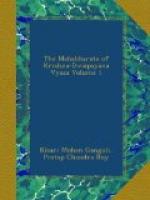that other fire who looks terrible when all the elements
are in a tranquil state is called the Manjuman fire;
he is the second son of Bhanu. And the fire in
whose honour oblations of clarified butter are enjoined
to be made here at the Darsa and Paurnamasya sacrifices
and who is known as Vishnu in this world, is (the
third son of Bhanu) called Angiras, or Dhritiman.
And the fire to whom with Indra, the Agrayana oblation
is enjoined to be made is called the Agrayana fire.
He is the (fourth) son of Bhanu. The fifth son
of Bhanu is Agraha who is the source of the oblations
which are daily made for the performance of the Chaturmasya
(four-monthly) rites. And Stuva is the sixth son
of Bhanu. Nisa was the name of another wife of
that Manu who is known by the name of Bhanu. She
gave birth to one daughter, the two Agnishomas, and
also five other fire-gods. The resplendent fire-god
who is honoured with the first oblations in company
with the presiding deity of the clouds is called Vaiswanara.
And that other fire who is called the lord of all the
worlds is Viswapati, the second son of Manu.
And the daughter of Manu is called Swistakrit, because
by oblations unto her one acquires great merit.
Though she was the daughter of Hiranyakasipu, she yet
became his wife for her evil deeds. She is, however,
one of the Prajapatis. And that other fire which
has its seats in the vital airs of all creatures and
animates their bodies, is called Sannihita. It
is the cause of our perceptions of sound and form.
That divine spirit whose course is marked with black
and white stains, who is the supporter of fire, and
who, though free from sin, is the accomplisher of
desired karma, whom the wise regard as a great Rishi,
is the fire Kapila, the propounder of the Yoga system
called Sankhya. The fire through whom the elementary
spirits always receive the offerings called Agra made
by other creatures at the performance of all the peculiar
rites in this world is called Agrani. And these
other bright fires famous in the world, were created
for the rectification of the Agnihotra rites when
marred by any defects. If the fires interlap each
other by the action of the wind, then the rectification
must be made with the Ashtakapala rites in honour
of the fire Suchi. And if the southern fire comes
in contact with the two other fires, then rectification
must be made by the performance of the Ashtakapala
rites in honour of the fire Viti. If the fires
in their place called Nivesa come in contact with the
fire called Devagni, then the Ashtakapala rites must
be performed in honour of the fire Suchi for rectification.
And if the perpetual fire is touched by a woman in
her monthly course, then for rectification the Ashtakapala
rites must be performed in honour of the fire called
Dasyuman. If at the time of the performance of
this Agnihotra rites the death of any creature is
spoken of, or if animals die, then rectification must
be made with the performance of the Ashtakapala rites




